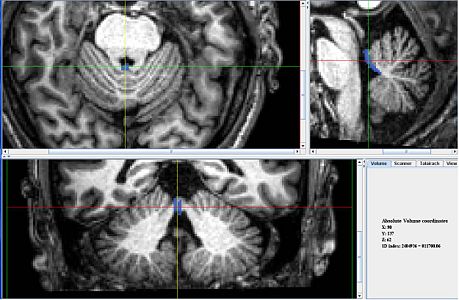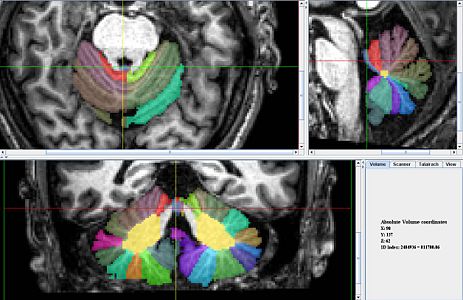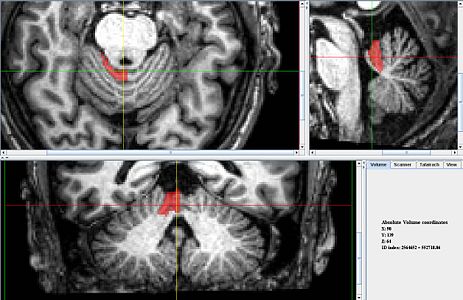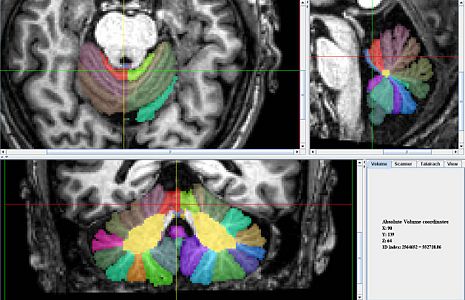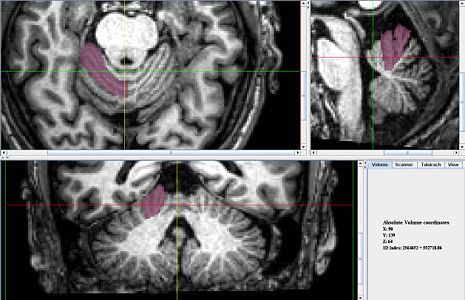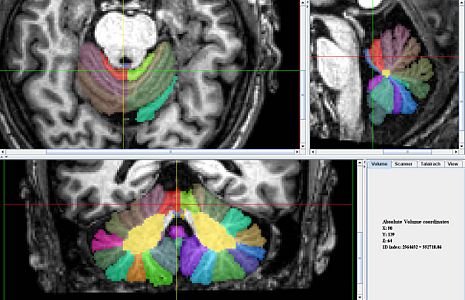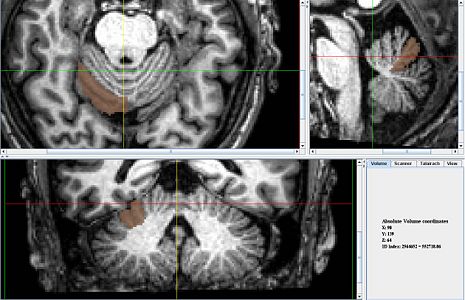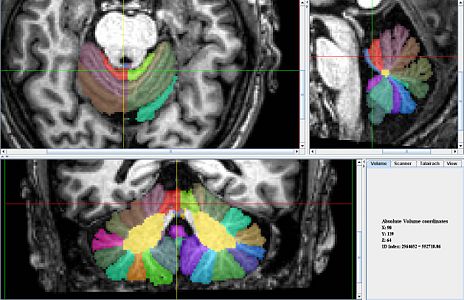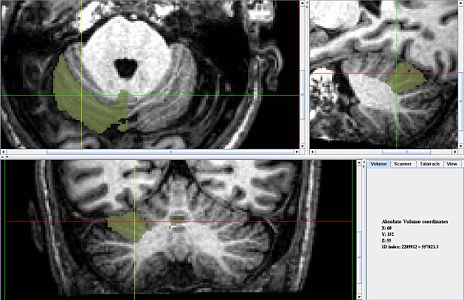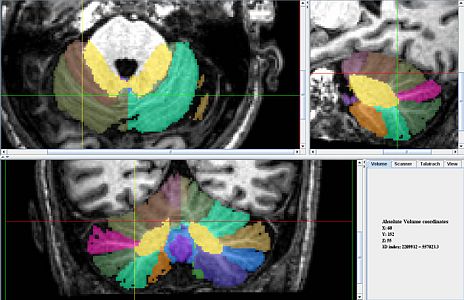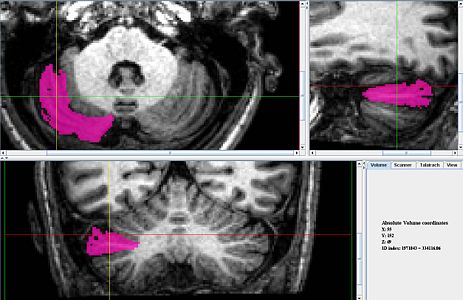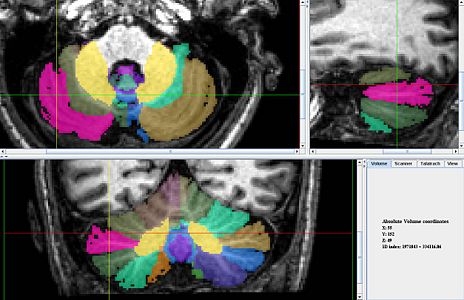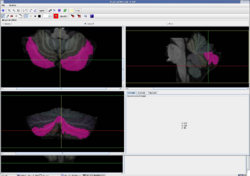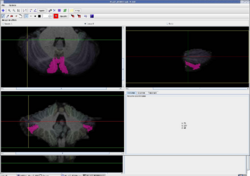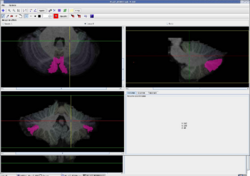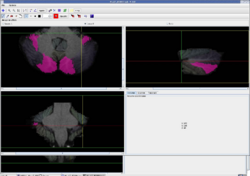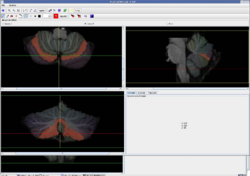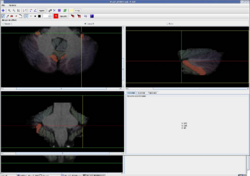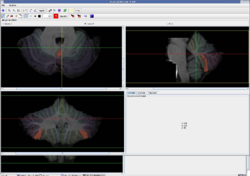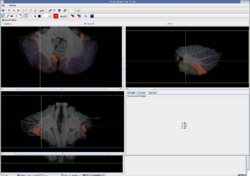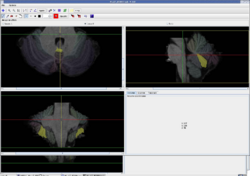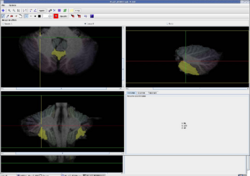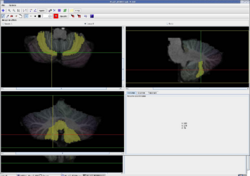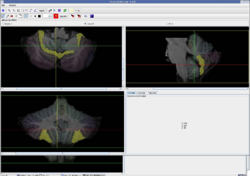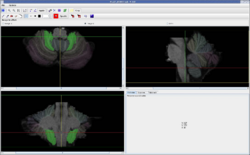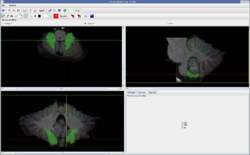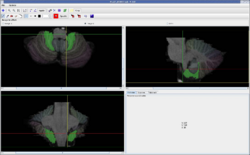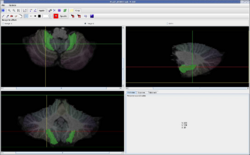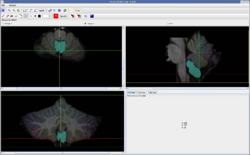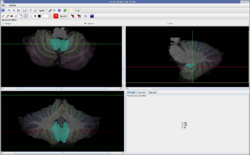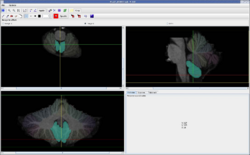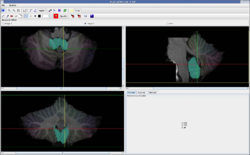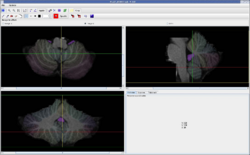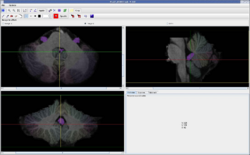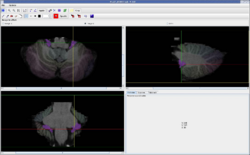Lobule Delineation
Jump to navigation
Jump to search
<meta name="title" content="Lobule Delineation"/>
| Cerebellum Protocol Project | |||
|---|---|---|---|
| Whole Cerebellum | Lobe Definitions | Vermis Definition | Lobule Delineation |
Painting conventions
Standard paint colors
- DNE - "Does not exist." There is no such anatomical structure.
Descriptions of All Cerebellar Lobules
Be sure to utilize MIPAV's locking function when delineating these lobules. Try to do them in a clockwise order so that you only have to be concerned with one boundary at a time and remember to lock the background and all other labels you are not using. When delineating save a file of masks without the delineation for the middle vermis.
The following pages contain various lobule screen shots. These screen shots were taken at different sections of the cerebellem in no particular sequence.
Lobules I/II
- Location: Within 10-12 slices to the left and right of the mid-sagittal in the mid horizontal region.
- Description: Very thin hair like lobule, best identified in the sagittal orientation as seen below. It is the small thin curve of grey matter bordering the superior cerebellar peduncles and nearly touching the spinal cord.
Lobule III
- Location: Anterior region of the cerebellum towards the top surface.
- Description: First fully visible lobule going clockwise (as shown below), best located in the midsagittal region.
- This lobule usually consists of only one major white matter branch and often near the boundaries of the spinal cord.
Lobule IV
- Location: Top portion of the cerebellum, focused around the midline
- Description: Can first be identified in the midsagittal slice, as the lobule to the left (inwards) of the top most vertical fissure (shown in Figure 41)
- It is bounded on one side by lobule III. On the other the boundary is the most prominent fissure between llobule III and the primary fissure.
Lobule V
- Location: Top portion of the cerebellum, focused mainly around the midline
- Description: Can first be identified in the midsagittal slice, as the lobule to the right (outwards) of the top most fissure (shown in Figure 44)
- If you have already defined the primary fissure (Lobe Definitions) and lobule IV then this definition should be trivial.
Lobule VI
- Location: Spans almost entire cerebellum, except the far lateral sides
- Description: One boundary is easily identifiable in the midsagittal region as there is a clear, wide fissure separating lobules V and VI (see Figure 47) (this should already be defined)
- On the other side it is bounded by VIIAf and VIIAt. The best way to see this boundary is the begin at the mid-line of the sagittal view and travel laterally about 15mm. You should see lobule VIIAf, which is not usually present in the midline grow in prominence. This is the second boundary for lobule VI and can be followed laterally in the sagittal view. When delineating the mid line maintain the already established anatomical boundary.
Lobule VIIA - Crus I
- Location: Spans entire cerebellum except for a few slices around the midsagittal
- Description: Best to initially identify from the most lateral edges (Figure 53) and the most posterior axial slice (Figure 51)
- Notice how this lobule is not in the midsagittal slice (Figure 51)
- This lobule can also be identified in the sagittal plane as the lobule that is not present at the mid-line but becomes easily discernible roughly 15 mm from the mid-line. It is usually one branch at first that may become two or more at the lateral edges. It should dominate the lateral portion of the cerebellum.
Lobule VIIA - Crus II
- Location: Spans entire cerebellum about middle of the sagittal orientation
- Description: This lobule can first be identified and painted in the midsagittal and then the paint can be propagated laterally, can also be seen in the posterior axial slices
- In the midsagittal region, there is an easy to define fissure separating this lobule and Lobule VIIIA (as shown in Figure 55)
- This fissure is primarily defined by the most dominate fissure between VIIAf and the prebiventure fissure, however determining which fissure qualifies can be difficult. Be patient and consider all perspectives and relavent regions of the scan in order to make the best decision possible.
Lobule VIIB
- Location: Middle region of cerebellum, extends from midsagittal to most lateral boundaries
- Description: Best to identify and label the boundaries for VIIIA and VIIAt before VIIB as this can be difficult to identify otherwise, first identification might best be made in the axial orientation towards the posterior end (see Figure 59)
- This lobule should be trivially defined by the prebiventure fissure (Lobe Definitions) and the boundary for VIIAt (Crus II)
Lobule VIIIA
- Location: Lower regions of the cerebellum, extends from midline laterally
- Description: Best to identify and label the boundary for VIIIB before VIIIA as the lower boundary can be difficult to identify otherwise
- The fissure between this lobule and Lobule VIIA Crus I is easily identified in the midsagittal slice as seen in Figure 63
- This lobule usually consists of one or two white matter branches and its second boundary is characterized by the exclusion of VIIIB which has a distinct curve.
Lobule VIIIB
- Location: Lower most region of the cerebellum in the sagittal orientation
- "Scoops" around the tonsils (hemispheric lobule IX). This can be most appreciated in the sagittal view. See the two middle images below.
- Description: can be identified as the lobule that curves around lobule IX as shown in Figure 68
- Notice how this lobule is not located in the midsagittal (Figure 67)
Lobule IX
- Location: Lowest portion of the cerebellum in the midsagittal
- Description: First identification can be made in the midsagittal as the region of the cerebellum that seems to be detached from the main branch (as shown in Figure 71) , after initial identification, the axial view is best for further delineation
- Best view(s) for delineation: Axial/ Coronal/ Sagittal
- It is fastest to delineate in the Coronal view because here it is a straight line instead of a circle.
Lobule X
- Location: Within 10 slices to the left and right of the midsagittal along the vermis section, and also the flocculi (anterior portion of the cerebellum)
- Description: Flocculi best identified in the coronal orientation, anterior most part of the cerebellum located in the center
- Best view(s) for delineation*: Axial/ Sagittal/ Coronal for the flocculi
- It is the most anterior and shortest of the gray matter in the sagittal view but is not present throughout.
Vermis Lobule VIIIA
- This is the small posterior most part of the vermis and seems to take only half of the posterior most white matter trunk.
- It was the lobule that was present in the most lateral slices of the vermis and appeared to meet lobule XIIIA in the axial plane.It was best delineated in the sagittal plane.
Vermis Lobule VIIIB
- This lobule is the other half of the posterior most white matter branch and is present, laterally, nearly as long as Lobule VIIIA. It was also best delineated in the sagittal plane.
Vermis Lobule IX
- This lobule is a triangular shape and is bordered on one side by Lobule VIIIB and on the other by X.
- It is the largest lobe in the sagittal view of the midline. The border between IX and X is a fissure that reached the CM and can be determined by considering the difference in the branches on either side. It was best delineated in the sagittal plane.
Vermis Lobule X
- Lobule X is the anterior most lobule of the vermis and contained no fissures. It is present in more lateral slices than lobule IX but only barely.
- The fissure separating lobules IX and X often grew as one progressed laterally in the sagittal view, and these lobules would sometime be separated by Lobule IX of the hemisphere.
- Lobule X of the vermis is disjoint from lobule X of the hemisphere. This was also best delineated in the sagittal view.
